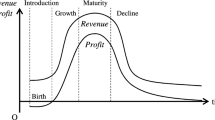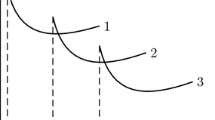Abstract
This paper presents a model of a firm's R&D behavior over an entire product life cycle. Beginning with the search stage, modelled as a patent race, firms raise their R&D expenditures until one firm succeeds with a technological breakthrough in creating a new product, market. The following R&D behavior of the successful entrepreneur, devoted to incremental product and process innovations, varies in a characteristic way over the new product's life cycle. Under reasonable conditions, R&D activities rise in the early stages but decline when the market matures. Overall, supply and demand factors combine to determine the R&D time-path.
Similar content being viewed by others
References
Audretsch DB (1987) An empirical test of the industry life cycle. Weltwirtschaftliches Archiv 123:297–308
Baldwin WL, Scott JT (1987) Market structure and technological change. Harwood Academic Publishers, New York, London
Cohen WM, Levin RC (1989) Empirical studies of innovation and market structure. In: Schmalensee R, Willig RD (eds) Handbook of industrial organization. North-Holland, Amsterdam vol. II., pp. 1059–1107
Cox WE (1967) Product life cycles as marketing models. Journal of Business 40:375–384
Dasgupta PS, Stiglitz JE (1980a) Industrial structure and the nature of innovative activity. Economic Journal 90:266–293
Dasgupta PS, Stiglitz JE (1980b) Uncertainty, industrial structure, and the speed of R&D. Bell Journal of Economics 11:1–28
Dasgupta PS, Stiglitz JE (1981) Entry, innovation, exit. Towards a dynamic theory of oligopolistic industrial structure. European Economic Review 15:137–158
Dosi G (1982) Technological paradigms and technological trajectories. Research Policy 11:147–162
Dosi G (1988) Sources, procedures, and microeconomic effects of innovation. Journal of Economic Literature 26:1120–1171
Flaherty MT (1980) Industry structure and cost-reducing investment Econometrica 48:1187–1209
Fudenberg D, Gilbert R, Stiglitz J, Tirole J (1983) Preemption, leapfrogging and competition in patent races. European Economic Review 22:3–31
Futia CA (1980) Schumpeterian competition. Quarterly Journal of Economics 94:675–695
Ghemawat P, Nalebuff B (1985) Exit. Rand Journal of Economics 16:184–194
Ghemawat P, Nalebuff B (1990) The devolution of declining industries. Quarterly Journal of Economics 105:167–186
Gort M, Klepper S (1982) Time paths in the diffusion of product innovations. Economic Journal 92:630–653
Gort M, Wall RA (1986) The evolution of technologies and investment in innovations. Economic Journal 96:741–757
Grossman GM, Shapiro C (1986) Optimal dynamic R&D programs. Rand Journal of Economics 17:581–593
Grossman GM, Shapiro C (1987) Dynamic R&D competition. Economic Journal 97:372–387
Harris CJ, Vickers JS (1987) Racing with uncertainty. Review of Economic Studies 54:1–21
Iwai K (1984) Schumpeterian dynamics Part II, Technological progress, firm growth and economic selection. Journal of Economic Behavior and Organization 5:321–351
Jovanovic B (1982) Selection and the evolution of industry. Econometrica 50:649–670
Kamien MI, Schwartz NL (1972) Timing of innovations under rivalry. Econometrica 40:43–60
Kamien MI, Schwartz NL (1974) Patent life and R&D rivarly. American Economic Review 64:183–187
Kamien MI, Schwartz NL (1976) On the degree of rivalry for maximum innovative activity. Quarterly Journal of Economics 90:245–260
Kamien MI, Schwartz NL (1980) A generalized hazard rate. Economics Letters 5:245–249
Kamien MI, Schwartz NI (1982) Market structure and innovation. Cambridge University Press, Cambridge
Klepper S, Graddy E (1990) The evolution of new industries and the determinants of market structure. Rand Journal of Economics 21:27–44
Kreps DM, Spence M (1985) Modelling the role of history in industrial organization and competition. In: Feiwel GR (ed) Issues in contemporary microeconomics and welfare. Basingstoke, London, pp. 340–378
Lee TK, Wilde LL (1980) Market structure and innovation: a reformulation. Quarterly Journal of Economics 94:429–436
Levin RC, Klevorick AK, Nelson RR, Winter SG (1987) Appropriating the returns from industrial research and development. Brookings Papers on Economic Activity, pp. 783–820.
Londregan J (1990) Entry and exit over the industry life cycle. Rand Journal of Economics 21:446–458
Loury GC (1979) Market structure and innovation. Quarterly Journal of Economics 93:395–410
Mueller DC, Tilton JE (1969) Research and development costs as a barrier to entry. Canadian Journal of Economics 2:570–579
Nelson RR, Winter SG (1982) An evolutionary theory of economic change. Harvard University Press, Cambridge, London
Polli R, Cook V (1969) Validity of the product life cycle. Journal of Business 42:385–400
Reinganum JF (1981) Dynamic games of innovation. Journal of Economic Theory 25:21–41
Reinganum JF (1982) A dynamic game of R & D: patent protection and competitive behavior. Econometrica 50:671–688
Reinganum JF (1985) Innovation and industry evolution. Quarterly Journal of Economics 100:81–99
Reinganum JF (1989) The timing of innovation: research, development, and diffision. In: Schmalensee R, Willig RD (eds) Handbook of industrial organization. North-Holland, Amsterdam, vol. I, pp. 849–908
Robinson B, Lakhani C (1975) Dynamic price models for new-product planning. Management Science 21:1113–1122
Sato R, Tsutsui S (1984) Technical progress, the Schumpeterian hypothesis and market structure. Zeitschrift für Nationalökonomie, Suppl. 4, Entrepreneurship, pp. 1–37.
Scherer FM (1984) Inovation and growth. Schumpeterian perspectives. MIT Press, Cambridge
Scherer FM, Ross D (1990) Industrial market structure and economic performance. 3rd ed. Rand McNally, Chicago
Schmookler J (1966) Invention and economic growth. Harvard University Press, Cambridge
Schumpeter JA (1942) Capitalism, socialism, and democracy. 3rd ed., Harper & Row, New York
Spence M (1986) Cost reduction, competition and industry performance. In: Stiglitz JE, Mathewson GF (eds) New developments in the analysis of market structure. MacMillan, Cambridge, pp. 475–515
Thirtle C, Ruttan VW (1987) The role of demand and supply in the generation and diffusion of technical change. Harwood Academic Publishers, New York, London
Utterback J (1979) The dynamics of product and process innovation in industry. In: Hill C, Utterback J (eds) Technological innovation for a dynamic economy. Pergamon Press, New York, pp. 40–65
Utterback J, Abernathy WY (1975) A dynamic model of process and product innovation. Omega 3:639–656
Wells LT (1972) The product life cycle and international trade. Harvard Business School, Boston
Author information
Authors and Affiliations
Rights and permissions
About this article
Cite this article
Stadler, M. R&D dynamics in the product life cycle. J Evol Econ 1, 293–305 (1991). https://doi.org/10.1007/BF01236495
Issue Date:
DOI: https://doi.org/10.1007/BF01236495




